同济大学:《设计研究与写作》课程电子教案(PPT课件)Lecture 07 Data collection methods

OHua DONG,Tongji University Lecture 7 Data collection methods
Lecture 7 Data collection methods ©Hua DONG, Tongji University

Hua DONG,Tongji University Data collection methods Surveys and questionnaires Interviews Observational methods Content analysis
Data collection methods Surveys and questionnaires Interviews Observational methods Content analysis ©Hua DONG, Tongji University

OHua DONG,Tongji University Data collection methods Surveys and questionnaires Interviews Observational methods Content analysis
Data collection methods Surveys and questionnaires Interviews Observational methods Content analysis ©Hua DONG, Tongji University
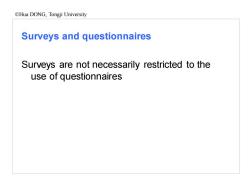
Hua DONG,Tongji University Surveys and questionnaires Surveys are not necessarily restricted to the use of questionnaires
Surveys and questionnaires Surveys are not necessarily restricted to the use of questionnaires ©Hua DONG, Tongji University
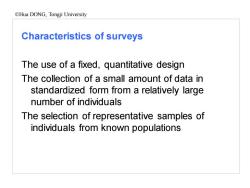
OHua DONG,Tongji University Characteristics of surveys The use of a fixed,quantitative design The collection of a small amount of data in standardized form from a relatively large number of individuals The selection of representative samples of individuals from known populations
Characteristics of surveys The use of a fixed, quantitative design The collection of a small amount of data in standardized form from a relatively large number of individuals The selection of representative samples of individuals from known populations ©Hua DONG, Tongji University

Hua DONG,Tongji University Why a survey? Surveys are almost always carried out as part of a non-experimental fixed design. Surveys are not well suited to carrying out exploratory work
Why a survey? Surveys are almost always carried out as part of a non-experimental fixed design. Surveys are not well suited to carrying out exploratory work. ©Hua DONG, Tongji University
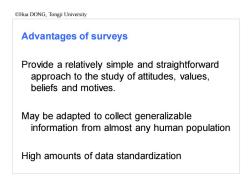
Hua DONG,Tongji University Advantages of surveys Provide a relatively simple and straightforward approach to the study of attitudes,values, beliefs and motives. May be adapted to collect generalizable information from almost any human population High amounts of data standardization
Advantages of surveys Provide a relatively simple and straightforward approach to the study of attitudes, values, beliefs and motives. May be adapted to collect generalizable information from almost any human population High amounts of data standardization ©Hua DONG, Tongji University
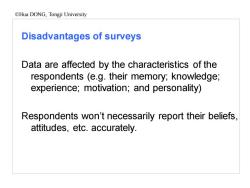
Hua DONG,Tongji University Disadvantages of surveys Data are affected by the characteristics of the respondents (e.g.their memory;knowledge; experience;motivation;and personality) Respondents won't necessarily report their beliefs, attitudes,etc.accurately
Disadvantages of surveys Data are affected by the characteristics of the respondents (e.g. their memory; knowledge; experience; motivation; and personality) Respondents won’t necessarily report their beliefs, attitudes, etc. accurately. ©Hua DONG, Tongji University
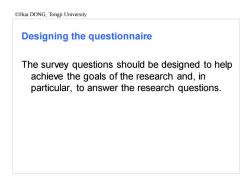
OHua DONG,Tongji University Designing the questionnaire The survey questions should be designed to help achieve the goals of the research and,in particular,to answer the research questions
Designing the questionnaire The survey questions should be designed to help achieve the goals of the research and, in particular, to answer the research questions. ©Hua DONG, Tongji University
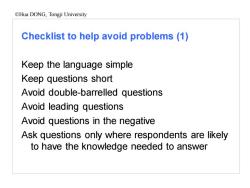
Hua DONG,Tongji University Checklist to help avoid problems (1) Keep the language simple Keep questions short Avoid double-barrelled questions Avoid leading questions Avoid questions in the negative Ask questions only where respondents are likely to have the knowledge needed to answer
Checklist to help avoid problems (1) Keep the language simple Keep questions short Avoid double-barrelled questions Avoid leading questions Avoid questions in the negative Ask questions only where respondents are likely to have the knowledge needed to answer ©Hua DONG, Tongji University
按次数下载不扣除下载券;
注册用户24小时内重复下载只扣除一次;
顺序:VIP每日次数-->可用次数-->下载券;
- 同济大学:《设计研究与写作》课程电子教案(PPT课件)Lecture 06 A design research methodology(DRM).ppt
- 同济大学:《设计研究与写作》课程电子教案(PPT课件)Lecture 05 Writing a research proposal.ppt
- 同济大学:《设计研究与写作》课程电子教案(PPT课件)Lecture 04 Literature review and referencing.ppt
- 同济大学:《设计研究与写作》课程电子教案(PPT课件)Lecture 03.ppt
- 同济大学:《设计研究与写作》课程电子教案(PPT课件)Lecture 02.ppt
- 同济大学:《设计研究与写作》课程电子教案(PPT课件)Lecture 01 Introduction Design Research and Writing(负责人:董华).ppt
- 三明学院:资源与化工学院通识类课程教学大纲(汇编).pdf
- 三明学院:教育与音乐学院学前教育专业课程教学大纲(汇编,2023级).pdf
- 同济大学:《公民教育专题》课程电子教案(PPT课件)Constitution and Citizen Education.pptx
- 同济大学:《公民教育专题》课程电子教案(PPT课件)Citizenship(主讲:薛念文).ppt
- 同济大学:《公民教育专题》课程电子教案(PPT课件)Citizenship of the EU Citizens education in the UK, France, Germany.pptx
- 同济大学:《公民教育专题》课程电子教案(PPT课件)Seminar on Citizen Education.pptx
- 同济大学:《公民教育专题》课程电子教案(PPT课件)Enterprise citizenship education.pptx
- 同济大学:《公民教育专题》课程电子教案(PPT课件)Patriotism And Citizenship Education.ppt
- 同济大学:《公民教育专题》课程电子教案(PPT课件)Citizenship and citizens education in the US.pptx
- 同济大学:《公民教育专题》课程电子教案(PPT课件)Discussion in the Classroom.ppt
- 同济大学:《公民教育专题》课程电子教案(PPT课件)Nature of citizenship and citizens education.pptx
- 同济大学:《心理学与行为科学导论》课程教学资源(电子教案)12 医院社会工作与健康促进.doc
- 同济大学:《心理学与行为科学导论》课程教学资源(电子教案)11 A. Language & communication B. Cross-cultural adaptation.doc
- 同济大学:《心理学与行为科学导论》课程教学资源(电子教案)10 Culture, mind & Health.doc
- 同济大学:《设计研究与写作》课程电子教案(PPT课件)Lecture 08 Writing strategies and ethical considerations.ppt
- 上海海洋大学:海洋学院2011年版课程教学大纲汇编(正文).pdf
- 上海海洋大学:人文学院2011年版课程教学大纲汇编(目录).pdf
- 上海海洋大学:人文学院2011年版课程教学大纲汇编(正文).pdf
- 上海海洋大学:综合与通识教育选修课教学大纲汇编(2018年版).pdf
- 上海海洋大学:马克思主义学院课程教学大纲汇编(2018版).pdf
- 上海海洋大学:综合与通识教育选修课程教学大纲汇编(2022年版).pdf
- 上海海洋大学:海洋文化与法律学院行政管理专业课程教学大纲汇编(2022年版).pdf
- 上海海洋大学:海洋文化与法律学院社会工作专业课程教学大纲汇编(2022年版).pdf
- 上海海洋大学:海洋文化与法律学院文化产业管理专业课程教学大纲汇编(2022年版).pdf
- 上海海洋大学:食品学院食品学院食品科学与工程专业教学大纲汇编(2022年版).pdf
- 上海海洋大学:海洋学院各专业课程教学大纲合集汇编(2022年版).pdf
- 上海海洋大学:水产与生命学院学院学科基础课及专业课教学大纲汇编(2022年版).pdf
- 上海海洋大学:海洋生态与环境学院各专业课程教学大纲汇编(2022年版).pdf
- 上海海洋大学:食品学院包装工程与生物制药专业教学大纲汇编(2022年版).pdf
- 上海海洋大学:马克思主义学院课程教学大纲汇编(2022年版).pdf
- 华南师范大学:《比较教育学》课程学习大纲.pdf
- 石河子大学:《学前儿童保育学》课程教学资源(实验指导)试验一.doc
- 石河子大学:《学前儿童保育学》课程教学资源(实验指导)实验二.doc
- 石河子大学:《学前儿童保育学》课程教学资源(实验指导)实验三.doc
